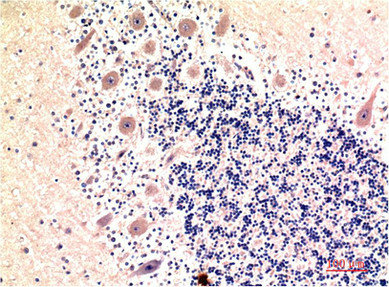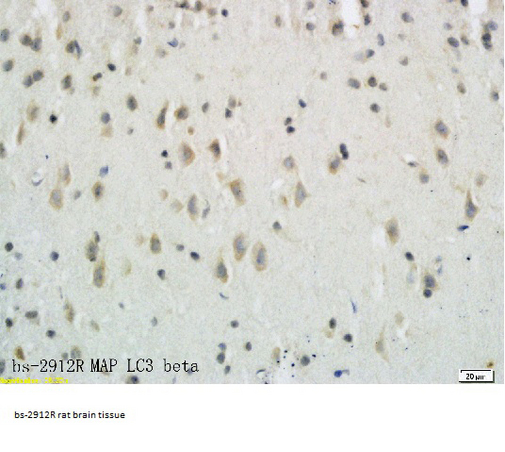LC3B antibody
GTX127375
ApplicationsElectron Microscopy, Flow Cytometry, ImmunoFluorescence, ImmunoPrecipitation, Western Blot, ImmunoCytoChemistry, ImmunoHistoChemistry, ImmunoHistoChemistry Frozen, ImmunoHistoChemistry Paraffin
Product group Antibodies
TargetMAP1LC3B
Overview
- SupplierGeneTex
- Product NameLC3B antibody
- Delivery Days Customer9
- Application Supplier NoteWB: 1:500-1:3000. ICC/IF: 1:100-1:1000. IHC-P: 1:100-1:1000. FACS: 1:50-1:200. IP: 1:100-1:500. *Optimal dilutions/concentrations should be determined by the researcher.Not tested in other applications.
- ApplicationsElectron Microscopy, Flow Cytometry, ImmunoFluorescence, ImmunoPrecipitation, Western Blot, ImmunoCytoChemistry, ImmunoHistoChemistry, ImmunoHistoChemistry Frozen, ImmunoHistoChemistry Paraffin
- CertificationResearch Use Only
- ClonalityPolyclonal
- Concentration0.34 mg/ml
- ConjugateUnconjugated
- Gene ID81631
- Target nameMAP1LC3B
- Target descriptionmicrotubule associated protein 1 light chain 3 beta
- Target synonymsATG8F; autophagy-related ubiquitin-like modifier LC3 B; LC3B; MAP1 light chain 3-like protein 2; MAP1A/1BLC3; MAP1A/MAP1B LC3 B; MAP1A/MAP1B light chain 3 B; MAP1LC3B-a; microtubule-associated proteins 1A/1B light chain 3B
- HostRabbit
- IsotypeIgG
- Protein IDQ9GZQ8
- Protein NameMicrotubule-associated proteins 1A/1B light chain 3B
- Scientific DescriptionThe product of this gene is a subunit of neuronal microtubule-associated MAP1A and MAP1B proteins, which are involved in microtubule assembly and important for neurogenesis. Studies on the rat homolog implicate a role for this gene in autophagy, a process that involves the bulk degradation of cytoplasmic component. [provided by RefSeq]
- Storage Instruction-20°C or -80°C,2°C to 8°C
- UNSPSC12352203
References
- Anti-proliferative activity of RIHMS-Qi-23 against MCF-7 breast cancer cell line is through inhibition of cell proliferation and senescence but not inhibition of targeted kinases.Read more
- Aqueous Nyctanthes arbortristis and doxorubicin conjugated gold nanoparticles synergistically induced mTOR-dependent autophagy-mediated ferritinophagy in paclitaxel-resistant breast cancer stem cells.Read more
- Hyperforin Enhances Heme Oxygenase-1 Expression Triggering Lipid Peroxidation in BRAF-Mutated Melanoma Cells and Hampers the Expression of Pro-Metastatic Markers.Read more
- Tumor suppressive functions of hsa-miR-34a on cell cycle, migration and protective autophagy in bladder cancer.Read more
- Copper Exposure Induces Epithelial-Mesenchymal Transition-Related Fibrotic Change via Autophagy and Increase Risk of Lung Fibrosis in Human.Read more
- Targeting influenza A virus by splicing inhibitor herboxidiene reveals the importance of subtype-specific signatures around splice sites.Read more
- Hyperforin Elicits Cytostatic/Cytotoxic Activity in Human Melanoma Cell Lines, Inhibiting Pro-Survival NF-kappaB, STAT3, AP1 Transcription Factors and the Expression of Functional Proteins Involved in Mitochondrial and Cytosolic Metabolism.Read more
- Oxygen-carrying sequential preservation mitigates liver grafts ischemia-reperfusion injury.Read more
- Size-Based Effects of Anthropogenic Ultrafine Particles on Lysosomal TRPML1 Channel and Autophagy in Motoneuron-like Cells.Read more
- Incomplete autophagy promotes the proliferation of Mycoplasma hyopneumoniae through the JNK and Akt pathways in porcine alveolar macrophages. Wen Y et al., 2022 Aug 4, Vet ResRead more







